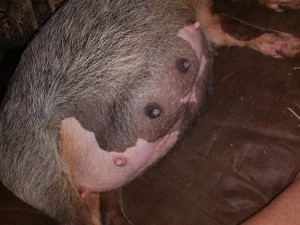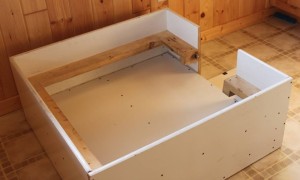Farrowing Basics
So you have got a pregnant sow/gilt (sows are girls who have given birth previously, gilts are girls in their first pregnancy) that’s nearing their due date and you want to make you’re prepared. First you want to make sure you’ve got all the supplies on hand that you might need.
• A farrowing pen/stall. This is important not only for the safety of the piglets but to help mom stay calmer when those protective instincts kick in. Make sure the mom-to-be is placed in her farrowing pen a good two or three weeks before her due date.
• At least one heat lamp with the red bulb. Babies do not retain heat very well. So they need an additional heat source even during the summer months. Your farrowing pen needs to be big enough for both mom and babies to have room to get away from the extra heat if needed.
• Wood shavings are better than straw for nesting and new mothers. Piglets tend to burrow into the straw and new mothers especially may lose track of them and end up laying on them. Wood shavings hold the heat from the heat lamp and also make it easier for mom to keep track of babies.
• A water bowl that the babies can climb out of in case they fall in. Piglets explore everything. It’s better to be extra cautious about these types of things.
• Sterile disposable gloves. These are great to have if you need to assist a piglet in the birth canal with your hand.
• Liquid iron drops or iron shots. Some breeders give them to every piglet and some will only administer to piglets showing signs of stress or even some not at all. I’ve found it’s better to have on hand just in case. When in doubt, always consult your vet on proper administration.
• Sharp edged pliers to cut needle/milk teeth. Again, some breeders cut a newborn piglet’s teeth and some don’t. It really depends on the mother as to whether they get their teeth clipped or not. Some won’t nurse with piglets shredding their nipples, others it doesn’t seem to faze at all. What it really comes down to, is do what’s best for your mother to ensure the babies get the colostrum and milk they need. Once you’re experienced with it, you can get it over in a few seconds per piglet. However, if teeth are going to be cut, it needs to be done as close to the birth as possible to cause the least amount of stress to the piglet.
• Towels, blankets, or cloth to clean the afterbirth off of the piglets. The quicker you get them dry the better off they’ll be, especially in colder temperatures.
• A small wire kennel to put in the corner of the farrowing pen to keep the babies safe and warm while mom finishes giving birth. Experience has taught me that not all mothers want the piglets right from the start. Some need time to get through the birthing process before starting to nurse, others need a few hours to calm down after giving birth the first time, and then others won’t be fazed by any of it. The wire kennel allows mom to see, smell and hear her babies without being able to hurt them if she’s upset by the birthing process. She’ll let you know when she wants them and you can slowly re-introduce them one at a time every few minutes until all are back with mom.
• Oxytocin on hand in case of problems with the placenta delivering and/or to facilitate milk let down. Always consult with your vet on dosage and use. If you can have it on hand for births great! If not, you know what to ask the doctor for.
• Spectogard Scour-Chek (spectinomycin) for cases of scours. Other medications are available for treating, this is just a basic low dose one that can easily be ordered online or picked up from your local farm co-op store.
• Iodine to dip the umbilical cords in. This is not an absolute, but it’s a good safety precaution against early infections.
• Either a baby camera or web camera set up to watch the farrowing pen. Again this isn’t necessary but it will make your life less stressful as you can check on them quickly without them knowing it.
• Bounce-Back for struggling piglets. This can be added to formula or goats milk if hand feeding is necessary.
• Canned or powdered goats milk. Fresh is even better. Rare cases of piglets cannot tolerate goat’s milk and those can be nursed with a sensitive stomach baby formula. However, goat’s milk is almost always the best thing for piglets if mom either dries up, refuses any of the babies or worst case, passes away. Moms who end up having emergency c-sections commonly lose their milk.
• Music. Pigs love music and having something soft and soothing playing during labor helps them as much as it does us. Take the time to get to know your mom-to-be and find out what type of music she likes. Yes, they do have preferences!
• A brush or fork to help relax her in between contractions. This will only work if she’s comfortable with you and wants you involved. There are some mothers that just want everyone to leave them alone until they’re done, or even after that. Each one’s needs should be respected. As long as the piglets are healthy and not in any danger from mom, let them be to have their bonding time together.
• Lots of feed for mom. Those babies are going to suck her dry if she isn’t getting fed enough. Nursing moms typically are eating at least double what they do regularly.
• And a camera. You’ll want lots of pictures of your new additions.
• A bucket of warm water as soon as active labor starts. Sometimes a piglet that seems lifeless can be brought back around with stimulation in warm water.
So now you’ve got all your supplies. What are the signs that your mom-to-be is going into labor. This is really individual to each pig. So don’t expect all of these examples to happen. In fact, you might not get any hints of them going into labor and then be surprised by multiple little faces looking at you when you go to feed or check on her. I’ve got one sow that has a milk line for over a week prior to birth and I swear she waits until she knows I’ve gone to bed before starting to nest. I have yet to see her give birth or even nest.
So here are some of the most common signs of early labor:
• Nesting. Some will pile everything they can find into a big nest. They’ll use their snouts and trotters to dig, shovel, or drag the wood shavings, straw or other bedding material to the spot they want. If blankets or beds are given to them they’ll use their mouths and trotters to shred it. This is usually an indication that babies will be coming within the next 24 hours or so. Some will only nest for a very short period before going into active labor.
• Refusing food. In my experience, this doesn’t happen a lot but it does happen. However, if they refuse more than one meal or aren’t drinking this is a sign of distress and they should be seen by a vet immediately.
• Milk lines appear. This one is tricky. As I mentioned above I have a sow that has her milk in for over a week sometimes before farrowing. Some will only get milk just before or not even until after the piglets are born and have stimulated milk flow.
 Some have a major attitude change. Some become clingy and need constant reassurance and others get ornery.
Some have a major attitude change. Some become clingy and need constant reassurance and others get ornery.
• Swelling. Her vulva will swell in preparation. Sometimes there is also a mucus discharge that is lubricating the birth canal.
• Teat enlargement.
• Restlessness. They stand up and lay back down almost immediately after.
• An increase in pooping. They tend to clean out their bowels just before active labor to make more room for piglets passing through the birth canal.
Now you’re in the active labor stage. Sows will deliver in a variety of positions: standing, squatting, or lying down. Most of my girls have their tail twitch and lift their upper hind leg and sometimes shiver just as piglet is about to present. She will be panting throughout this stage. Sometimes they’ll use multiple positions for one litter. This is normal and she should be allowed to deliver them however is most comfortable to her. You are there only to assist or step in during an emergency. This stage typically lasts between 3-8 hours with piglets delivered every 10-20 minutes. However, there is a wide variation to this.
Past history will give you the best indicator as to what’s normal for the mom. The longest I’ve had between healthy births is approximately 40 minutes. Anything over an hour is cause for concern and the vet should be called immediately. If you see her straining to push and no piglet is presenting, snap on your sterile gloves and see if you can feel the piglet inside the birth canal. She may need your help in pulling the piglet gently. Try to pull with the contractions. When in doubt always contact your vet.
The last stage is the delivery of the placenta. She can have up to two placentas, one from each horn of her uterus. Look for any signs of tearing in them to ensure she has not retained part of the placenta. This is typically the stage where the moms want their piglets and start to nurse. If a placenta hasn’t been delivered before she calls the babies to nurse, I simply watch her over the next few hours. It can take up to four hours according to my vet for the placenta to pass. As long as she isn’t showing signs of distress or lethargy I just keep an eye on her. Most of my moms will partially eat the placenta. This is okay and natural. If the placenta is still there at the next feeding I remove what remains. Monitor the sow and piglets very closely for at least 24 hours after birth.
Signs of Emergency In A Farrowing Sow
Indicating Emergency C Section
By Cathy Zolicani, DMV
- Active contractions with no production for 2 hours (I mean real effort here)
- Part of piglet, placenta or other tissue stuck in canal (either visible or you can feel it)
- Nesting, mid-range contractions for 8 hours with no production – warrants at least an exam and pos oxytocin
- True bleeding (rather than bloody discharge associated with birth) from mother (this would include very white gums when they are normally pink
- High temp (104 or above)
- Any breathing problems from the mother.
- Severe abdominal pain (called an acute abdomen) on the part of the mother.
- If the mother required a C-section before and shows any signs of difficulty – get her in for another.


